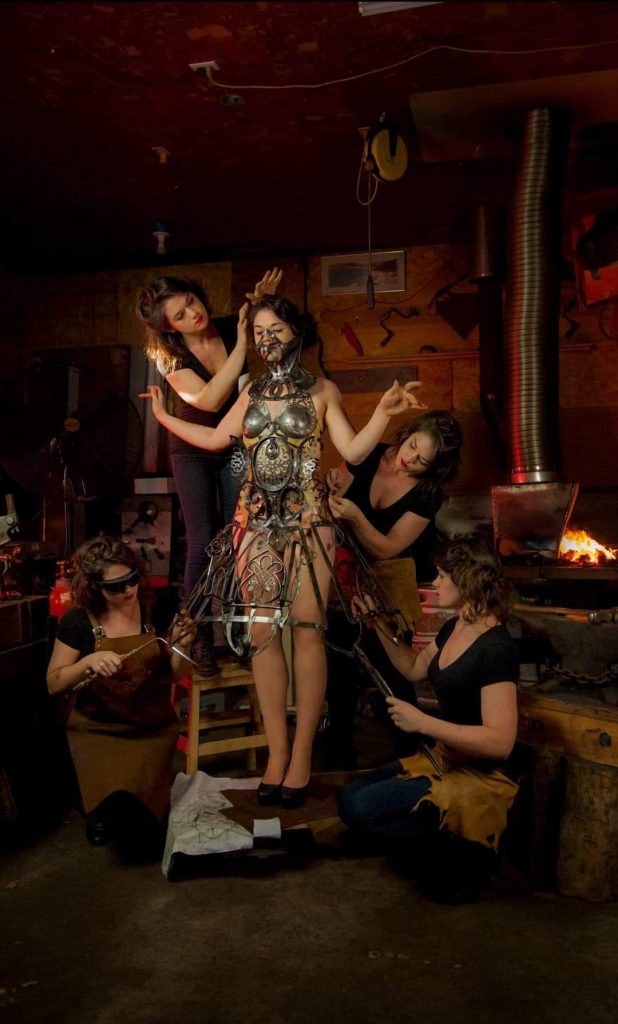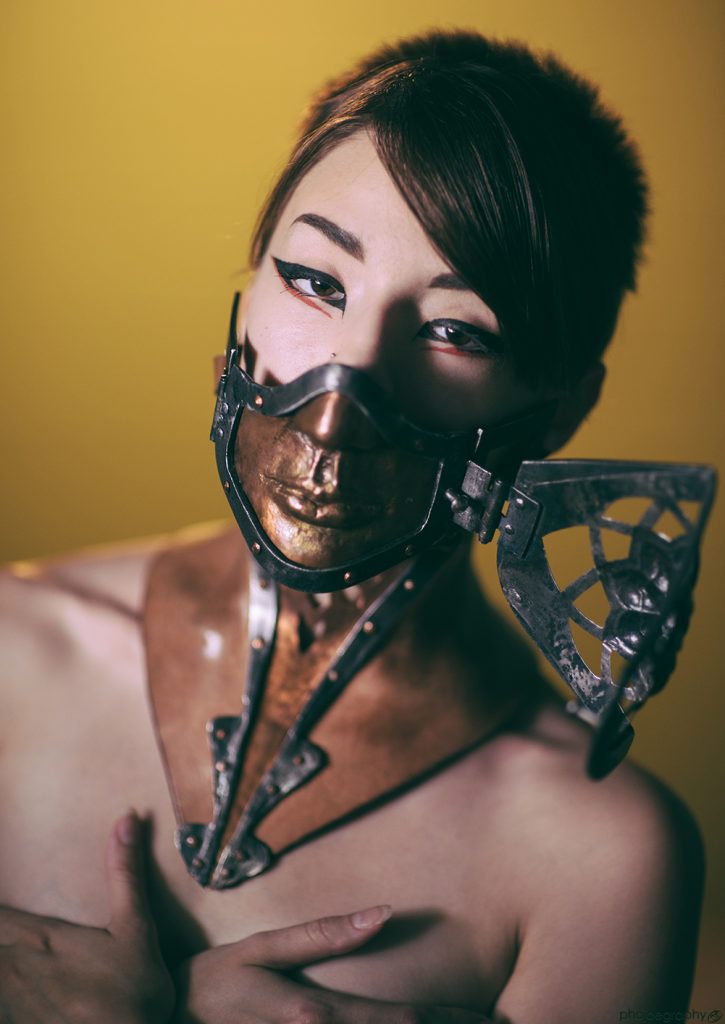In an industry divided by art and craft, blacksmith Ellen Durkan is forging her own path. Durkan creates intricate, complex, wearable art, known as “forged fashion.”
She was drawn to blacksmithing while pursuing a master’s degree in fine arts at Towson University. No one in the program was a blacksmith, but that wasn’t a problem for Durkan. She started messing around with metal and scored a blacksmith assistant position at Peters Valley School of Craft in the summer of 2008, which gave her a taste of what forging could be.
With no background in fashion and half a summer’s worth of ’smithing experience, Durkan got to work on her thesis—a runway show that combined her newfound love of blacksmithing with her passion for figurative work and performance art. The finished show featured six women in fabricated dress cages, complete with metal shoes. Durkan is open about the beginner quality of her early pieces. “They weren’t forged or fabricated particularly well, and they weren’t structurally sound, but you’ve gotta start somewhere,” she says. “I have to credit the exploration of crappy stuff that fit poorly and was extra stabby and all over the place.”
Today, Durkan’s wearables are dynamic, accessible, and significantly more comfortable thanks to clever leatherwork. Her portfolio includes copper collars with ruffles so smooth they look like fabric, armor-like bodices, curling skirts, soaring headpieces, and more. She makes all of it at Iron Maiden Forge, her one-person shop in Delaware.

Durkan’s work takes inspiration from numerous sources, including gothic architecture, Celtic knotwork, and Alexander McQueen. One of he favorite creations features a fitted neck piece and face covering. “I really like that piece because it’s conceptually dynamic, and on a technical level it’s dynamic,” she says. Inspired by triptychs, the face piece features three layers. The top layer is a cage-like steel face covering, which hinges open to reveal the second layer—a nose and mouth formed out of copper. The face looks like it could be from a mold, but Durkan actually hand-formed it using a chasing repoussé technique, where a design is created on the front side of a piece of metal by hammering the back side, and chasing involves pushing back metal on the front side to define a design.
The final layer opens to view the wearer’s own face. “I like working with pieces that the model can manipulate on the runway. The face piece goes with a skirt that has hinging doors and a tryptic opening that’s based on gothic architecture, and a rose window inspiration in the center,” says Durkan. “The model can open the doors on the skirt and on her face, so she’s in control of what she’s representing.”
Her work is a beautiful, impressive feat by itself, but it comes alive with new meaning when it’s worn. It gives power to the wearer, acting as literal and metaphorical armor that invites vulnerability, inspires confidence, symbolizes strength, and literally takes strength to wear. You can see the finished products—bodies wrapped in metal—at runway shows. One of the last shows Durkan held was in 2019, and it featured 45 minutes of original music, aerial performers, and 16 models from ages 15 to 72. The oldest model was a friend of a friend. “She was very reserved,” says Durkan with a smile, “and then as soon as she hit the runway she was just owning it. And she kept her piece on all night, the heels and skirt.”

This confidence is something Durkan also sees in students’ workshops, where she works with them to design and forge something to fit the neck or chest. It’s a class that not only teaches students about blacksmithing, but about themselves.
“It’s a personal exploration as well as a forging exploration,” says Durkan. “Most people aren’t super in tune with their bodies, and in order to make these pieces, they’re allowing me to help them. We get personal about stuff, their stories.” It’s an intimate process, forming metal around the curves of the body, and Durkan can see peoples’ confidence grow as they fit pieces to themselves, sometimes to cover insecurities, other times to embrace them.
From May 23-27 she’s teaching a five-day workshop at the Virginia Institute of Blacksmithing in Waynesboro—the only artistic blacksmithing school certified to operate by the State Council of Higher Education for Virginia. VIB offers a variety of classes that require no experience, like Durkan’s, as well as a Certificate of Artistic Blacksmithing, taught by co-founder Dale Morse.
Despite making art that’s undeniably badass and takes an extraordinary amount of skill, not everyone sees what Durkan is on to. In graduate school, Durkan says she was told not to pursue the direction she did, and today, she still faces pushback from a male-dominated industry. “I think it’s a little better now, but 12 years ago there was such a divide between art and craft, and you were just shoved into one of the dimensions,” she says. “If you have crossover, which I kind of do, the art world is like ‘well this is too much craft’, and the craft world is like, ‘there’s naked women, she’s dealing with emotional issues through metal, we don’t know what to do.’ But I just kept doing what I wanted, and eventually people came around and were like ‘Oh shit, maybe she’s doing something that other people might be interested in.’”
Durkan is still doing what she wants, and expressing herself through any art form she can get her hands on—ceramics, drawing, makeup, photography, pinup. “I don’t feel like I should be pigeonholed into just one thing. It’s all part of the same artistic expression. Do whatever you want to do.”
